Study on the Trade-Off Synergy Relationship of “Production-Living-Ecological” Functions in Chinese Counties: A Case Study of Chongqing Municipality
Abstract
1. Introduction
2. Materials and Methods
2.1. Study Area
2.2. Research Methods
2.2.1. Construction of PLEFs Evaluation Index System
- (1)
- Production function refers to the ability of the county land space to provide products for human beings and increase social wealth. Therefore, this paper characterizes the production function from the two criteria of agricultural production and economic development and selects grain yield, land reclamation rate, per capita grain ownership, average industrial production value, financial contribution rate, economic density, and other indicators to characterize the production function, all of which are positive indicators, and the larger the value, the stronger the production function of the county land space.
- (2)
- Living function refers to the ability of the county land space to provide a living environment for human beings, which can reflect the income, consumption structure, and welfare of residents. Therefore, this paper characterizes the living function from the two standard layers of life security and social services and selects indicators such as the proportion of housing area, the density of transportation land, the population density, the number of hospitals per 10,000 people, the number of beds, the total retail sales of social consumer goods per capita, and the number of books in the per capita public library collection. Population density is a negative indicator, and the larger the value, the weaker the living function of the county. The rest are positive indicators, and the larger the value, the stronger the county living function.
- (3)
- Ecological function refers to the ability of the county land space to provide ecological products and services for residents, as well as to respond to external interference, realize self-repair, maintain ecosystem stability, conserve water sources, and maintain ecological security. Therefore, this paper characterizes the strength of county ecological functions from the aspects of ecological pressure and ecological supply. The two indicators of agricultural fertilizer input intensity and land degradation index were selected to characterize the ecological stress function of the county, both of which were negative indicators. The larger the value, the weaker the ecological function of the county. The three indicators of per capita water resources, forest coverage, and habitat abundance index were selected to characterize the capacity of county ecological supply, all of which were positive indicators. The larger the value, the stronger the rural ecological function.
2.2.2. Functional Niche Width Evaluation Model of PLEFs
2.2.3. PLEFs Functional Coupling Coordination model
2.2.4. The PLEFs Weigh the Degree of Synergy
2.3. Data Sources and Preprocessing
2.3.1. Data Sources
2.3.2. Data Preprocessing
2.4. Technical Route
3. Results and Analysis
3.1. Characteristics of the Spatiotemporal Bureau of PLEFs in Chongqing City
3.1.1. Ecological Niche Evolution
- Production function niche width
- 2.
- Ecological niche width of living functions
- 3.
- Ecological function niche width
- 4.
- The comprehensive niche width of PLEFs
3.1.2. Temporal and Spatial Correlation Analysis
- Production function
- Living function
- Ecological function
3.2. Coupling and Coordination Analysis of PLEFs in Chongqing City
3.2.1. Coupling and Coordination Analysis of PLEFs
3.2.2. Coupling and Coordinated Analysis of Two Functions
- “Production-living” function
- “Production-ecological” function
- “Living-ecological” function
3.3. Synergy Trade-Off Analysis of PLEFs in Chongqing City and County
3.3.1. The Degree of Trade-Off Synergy of PLEFs of the County
3.3.2. The Trade-Off Synergy Relationship of PLEFs in the County from 2000 to 2020
4. Discussion
4.1. Contributions and Deficiencies
- (1)
- Due to the inconsistency of the statistical caliber of each county in the study area, coupled with the dilemma of data acquisition and limited technology, the data sources of some indicators have been replaced. Although explained in the text, there may also be the problem that the evaluation of PLEFs is not accurate enough, the research scale needs to be further refined, and measures and precise measures are implemented according to local conditions to make a systematic and overall evaluation of the coordinated development level of PLEFs.
- (2)
- Dynamic changes with time accompany the functional relationship of “production-living-ecological” in the county. The selected indicators in this paper mainly focus on the current and past periods and the future-oriented indicators. The complex relationship between them also needs to be further explored, so the continuity and dynamic transformation characteristics of the trade-off synergy of long-time series analysis must be further studied.
- (3)
- Many biological processes and physical and chemical mechanisms in the PLES in the county. In the future, it is necessary to strengthen the exploration and analysis of biological, physical, and chemical processes and pay more attention to the interpretation of biological, physical, and chemical processes to clarify the driving mechanism of PLEFs better to improve the resilience and stability of the ecosystem and promote sustainable development under the effective synergy of PLEFs.
4.2. Policies and Recommendations
- (1)
- For the main urban metropolitan areas with “production living” functional advantages, each district should take economic development as the premise, ecological protection as the foundation, and improving the quality of life as the goal, strengthen economic ties, coordinate the development, avoid low-level, repetitive construction of homogeneous and disorderly competition, and radiate and drive the economic development of the NE and SE. For the NE and SE, which has the functional advantages of “production ecology” and “living ecology,” the NE and SE regions should utilize the advantages of the natural environment and landscape resources, encourage the development of a “low-carbon economy,” complement and compete with the advantages of the main urban areas, and form a sizeable industrial pattern of differentiated and coordinated development, and explore the integrated development path of PLEFs.
- (2)
- Overall, the development trend of PLEFs coupling coordination in Chongqing presents a benign trend. The “production-living” function is mainly low-level imbalance, so it is more feasible to improve the coordination of PLEFs. When formulating policy measures, we should focus on improving the people’s living standards and strengthening infrastructure construction to improve the green living index. The main urban area should improve the livability of living space, promote the progress of new energy technology, upgrade and transform industrial industries, and promote supply-side structural reform. Use benign and green industrial development to meet people’s growing needs for a better living. In terms of “production-ecological” and “living-ecological” functions, it is necessary to strengthen further the concept of “green water and green mountains are golden mountains and silver mountains,” change the traditional industrial development model, adjust and optimize the economic structure, vigorously develop the ecological economy and circular economy, and continuously promote the normalization and institutionalization of ecological governance, to promote Chongqing’s road of “ecological priority and green development.”
5. Conclusions
- (1)
- Significant diversity exists in Chongqing’s spatiotemporal differentiation characteristics of PLEFs. During the study period, the overall growth trend of production niche width, the high-value area was mainly located in the UC, and the downward trend in the Dadukou district was noticeable. The width of the living niche showed fluctuating and zonal growth, and most areas generally showed an expansion trend from 2000 to 2010, while the main urban areas showed a contraction or flat trend from 2010 to 2020.
- (2)
- PLEFs and the coupling degree between the two functions in Chongqing City and county show the distribution characteristics of “high in the west and low in the east,” and the whole is moving towards the stage of coordinated coupling. Among them, the “production-living” function has the highest coupling level and the most robust interaction between the two, while the “production-ecological” function and the “living-ecological” function are the second.
- (3)
- The spatial and temporal differences in the coupling and coordination degree of PLEFs in Chongqing City and County are significant. Overall, it is manifested as “high in the west and low in the east” and from the primary imbalance to a well-coordinated development feature. It presents an inverted “U” shaped evolutionary trend. It means that with further development, the gap in the degree of coupling and coordination of PLEFs in each county will be further expanded and narrowed.
- (4)
- On the whole, in the past 20 years, the “living-production” function in Chongqing has changed from a trade-off to a collaborative development relationship, the “living-ecological” function is generally based on the collaborative development relationship, and the trade-off constraint relationship dominates the “production-ecological” function; Moreover, the coordinated development level of “living-production,” “living-ecological,” and “production-ecological” functions in the central urban area has been dramatically improved, while the county has gradually shown different degrees of trade-offs.
Author Contributions
Funding
Institutional Review Board Statement
Informed Consent Statement
Data Availability Statement
Conflicts of Interest
References
- Costanza, R.; de Groot, R.; Sutton, P.; vander Ploeg, S.; Anderson, S.J.; Kubiszewski, I.; Farber, S.; Turner, R.K. Changes in the global value of ecosystem services. Glob. Environ. Chang. 2014, 26, 152–158. [Google Scholar] [CrossRef]
- Pauleit, S.; Duhme, F. Assessing the environmental performance of land cover types for urban planning. Landsc. Urban Plan. 2000, 52, 1–20. [Google Scholar] [CrossRef]
- Smith, J.M.; Price, G.R. The Logic of Animal Conflict. Nature 1973, 246, 15–18. [Google Scholar] [CrossRef]
- Xiao, P.; Xu, J.; Zhao, C. Conflict Identification and Zoning Optimization of “Production-Living-Ecological” Space. Int. J. Environ. Res. Public Health 2022, 19, 7990. [Google Scholar] [CrossRef] [PubMed]
- Myers, N. Population, Environment, and Conflict. Environ. Conserv. 1987, 14, 15–22. [Google Scholar] [CrossRef]
- Stehfest, E.; van Zeist, W.-J.; Valin, H.; Havlik, P.; Popp, A.; Kyle, P.; Tabeau, A.; Mason-D’Croz, D.; Hasegawa, T.; Bodirsky, B.L.; et al. Key determinants of global land-use projections. Nat. Commun. 2019, 10, 2166. [Google Scholar] [CrossRef]
- Sutton, P.C.; Anderson, S.J.; Costanza, R.; Kubiszewski, I. The ecological economics of land degradation: Impacts on ecosystem service values. Ecol. Econ. 2016, 129, 182–192. [Google Scholar] [CrossRef]
- Wang, H.; Long, H.; Li, X.; Yu, F. Evaluation of changes in ecological security in China’s Qinghai Lake Basin from 2000 to 2013 and the relationship to land use and climate change. Environ. Earth Sci. 2014, 72, 341–354. [Google Scholar] [CrossRef]
- Masoudi, M.; Tan, P.Y.; Fadaei, M. The effects of land use on spatial pattern of urban green spaces and their cooling ability. Urban Clim. 2021, 35, 100743. [Google Scholar] [CrossRef]
- Xie, X.; Li, X.; Fan, H.; He, W. Spatial analysis of production-living-ecological functions and zoning method under symbiosis theory of Henan, China. Environ. Sci. Pollut. Res. 2021, 28, 69093–69110. [Google Scholar] [CrossRef]
- Duan, Y.; Xu, Y.; Huang, A.; Lu, L.; Ji, Z. Progress and prospects of “production-living-ecological” functions evaluation. J. China Agric. Univ. 2021, 26, 113–124. [Google Scholar] [CrossRef]
- Liu, Y. On the logical structure, check and balance mechanism and development principle of “three living spaces”. Hubei Soc. Sci. 2016, 3, 5–9. [Google Scholar] [CrossRef]
- Haken, H. Advanced Synergetics; Springer: Berlin/Heidelberg, Germany, 1983. [Google Scholar]
- Feng, Q.; Zhao, W.; Fu, B.; Ding, J.; Wang, S. Ecosystem service trade-offs and their influencing factors: A case study in the Loess Plateau of China. Sci. Total Environ. 2017, 607–608, 1250–1263. [Google Scholar] [CrossRef] [PubMed]
- Nelson, E.; Mendoza, G.; Regetz, J.; Polasky, S.; Tallis, H.; Cameron, D.; Chan, K.M.A.; Daily, G.C.; Goldstein, J.; Kareiva, P.M.; et al. Modeling multiple ecosystem services, biodiversity conservation, commodity production, and trade-offs at landscape scales. Front. Ecol. Environ. 2009, 7, 4–11. [Google Scholar] [CrossRef]
- Liu, J.; Jiang, Z. The Synergy Theory of Economic Growth; Springer: Singapore, 2018. [Google Scholar]
- Liu, Y.; Liu, X.; Zhao, C.; Wang, H.; Zang, F. The trade-offs and synergies of the ecological-production-living functions of grassland in the Qilian mountains by ecological priority. J. Environ. Manag. 2023, 327, 116883. [Google Scholar] [CrossRef]
- Chen, C.; He, X.; Liu, Z.; Sun, W.; Dong, H.; Chu, Y. Analysis of regional economic development based on land use and land cover change information derived from Landsat imagery. Sci. Rep. 2020, 10, 12721. [Google Scholar] [CrossRef]
- Chang, X.; Zhang, F.; Cong, K.; Liu, X. Scenario simulation of land use and land cover change in mining area. Sci. Rep. 2021, 11, 12910. [Google Scholar] [CrossRef]
- Huang, j.; Lin, H.; Qi, X. A literature review on optimization of spatial development pattern based on ecological-production-living space. Prog. Geogr. 2017, 36, 378–391. [Google Scholar] [CrossRef]
- Bliege Bird, R.; Nimmo, D. Restore the lost ecological functions of people. Nat. Ecol. Evol. 2018, 2, 1050–1052. [Google Scholar] [CrossRef]
- Havel, M.B. Delineation of property rights as institutional foundations for urban land markets in transition. Land Use Policy 2014, 38, 615–626. [Google Scholar] [CrossRef]
- Lu, L.; Zhou, S.; Zhou, B.; Dai, L.; Ting, C.; Bao, G.; Hua, Z.; Zhi, L. Land Use Transformation and Its Eco-environmental Response in Process of the Regional Development: A Case Study of Jiangsu Province. Sci. Geogr. Sin. 2013, 33, 1442–1449. [Google Scholar] [CrossRef]
- Yang, Q.; Duan, X.; Wang, L.; Jin, Z. Land Use Transformation Based on Ecological-production-living Spaces and Associated Eco-environment Effects: A Case Study in the Yangtze River Delta. Sci. Geogr. Sin. 2018, 38, 97–106. [Google Scholar] [CrossRef]
- Geng, S.; Zhu, W.; Shi, P. A Functional Land Use Classification for Ecological, Production and Living Spaces in the Taihang Mountains. J. Resour. Ecol. 2019, 10, 246. [Google Scholar] [CrossRef]
- Moore, A.L.; McCarthy, M.A. Optimizing ecological survey effort over space and time. Methods Ecol. Evol. 2016, 7, 891–899. [Google Scholar] [CrossRef]
- Li, J.; Sun, W.; Li, M.; Linlin, M. Coupling coordination degree of production, living and ecological spaces and it’s influencing factors in the Yellow River Basin. J. Clean. Prod. 2021, 298, 126803. [Google Scholar] [CrossRef]
- Yang, Y.; Bao, W.; Liu, Y. Coupling coordination analysis of rural production-living-ecological space in the Beijing-Tianjin-Hebei region. Ecol. Indic. 2020, 117, 106512. [Google Scholar] [CrossRef]
- Li, F.; Wang, R.; Hu, D.; Ye, Y.; Yang, W.; Liu, H. Measurement methods and applications for beneficial and detrimental effects of ecological services. Ecol. Indic. 2014, 47, 102–111. [Google Scholar] [CrossRef]
- Reynolds, C.S. Ecological pattern and ecosystem theory. Ecol. Model. 2002, 158, 181–200. [Google Scholar] [CrossRef]
- Liu, C.; Xu, Y.; Lu, X.; Han, J. Trade-offs and driving forces of land use functions in ecologically fragile areas of northern Hebei Province: Spatiotemporal analysis. Land Use Policy 2021, 104, 105387. [Google Scholar] [CrossRef]
- Zong, S.; Hu, Y.; Zhang, Y.; Wang, W. Identification of land use conflicts in China’s coastal zones: From the perspective of ecological security. Ocean Coast. Manag. 2021, 213, 105841. [Google Scholar] [CrossRef]
- Scheidel, A.; Temper, L.; Demaria, F.; Martínez-Alier, J. Ecological distribution conflicts as forces for sustainability: An overview and conceptual framework. Sustain. Sci. 2018, 13, 585–598. [Google Scholar] [CrossRef] [PubMed]
- Perminova, T.; Sirina, N.; Laratte, B.; Baranovskaya, N.; Rikhvanov, L. Methods for land use impact assessment: A review. Environ. Impact Assess. Rev. 2016, 60, 64–74. [Google Scholar] [CrossRef]
- LaGro, J.A. Land-use classification. In Encyclopedia of Soils in the Environment; Hillel, D., Ed.; Elsevier: Oxford, UK, 2005; pp. 321–328. [Google Scholar]
- Liu, N.; Liu, C.; Xia, Y.; Da, B. Examining the coordination between urbanization and eco-environment using coupling and spatial analyses: A case study in China. Ecol. Indic. 2018, 93, 1163–1175. [Google Scholar] [CrossRef]
- Ding, L.; Zhao, W.; Huang, Y.; Cheng, S.; Liu, C. Research on the Coupling Coordination Relationship between Urbanization and the Air Environment: A Case Study of the Area of Wuhan. Atmosphere 2015, 6, 1539–1558. [Google Scholar] [CrossRef]
- Zhang, Y.; Shen, L.; Shuai, C.; Bian, J.; Zhu, M.; Tan, Y.; Ye, G. How is the environmental efficiency in the process of dramatic economic development in the Chinese cities? Ecol. Indic. 2019, 98, 349–362. [Google Scholar] [CrossRef]
- Lu, H.; Zhou, L.; Chen, Y.; An, Y.; Hou, C. Degree of coupling and coordination of eco-economic system and the influencing factors: A case study in Yanchi County, Ningxia Hui Autonomous Region, China. J. Arid Land 2016, 9, 446–457. [Google Scholar] [CrossRef]
- Zhou, D.; Xu, J.; Lin, Z. Conflict or coordination? Assessing land use multi-functionalization using production-living-ecology analysis. Sci. Total Environ. 2017, 577, 136–147. [Google Scholar] [CrossRef]
- Song, Q.; Zhou, N.; Liu, T.; Siehr, S.A.; Qi, Y. Investigation of a “coupling model” of coordination between low-carbon development and urbanization in China. Energy Policy 2018, 121, 346–354. [Google Scholar] [CrossRef]
- Lai, Z.; Ge, D.; Xia, H.; Yue, Y.; Wang, Z. Coupling coordination between environment, economy and tourism: A case study of China. PLoS ONE 2020, 15, e0228426. [Google Scholar] [CrossRef]
- Hou, C.; Chen, H.; Long, R. Coupling and coordination of China’s economy, ecological environment and health from a green production perspective. Int. J. Environ. Sci. Technol. 2022, 19, 4087–4106. [Google Scholar] [CrossRef]
- Zeng, P.; Wei, X.; Duan, Z. Coupling and coordination analysis in urban agglomerations of China: Urbanization and ecological security perspectives. J. Clean. Prod. 2022, 365, 132730. [Google Scholar] [CrossRef]
- Zhang, X.; Xu, Z. Functional Coupling Degree and Human Activity Intensity of Production–Living–Ecological Space in Underdeveloped Regions in China: Case Study of Guizhou Province. Land 2021, 10, 56. [Google Scholar] [CrossRef]
- Wang, Y.; Geng, Q.; Si, X.; Kan, L. Coupling and coordination analysis of urbanization, economy and environment of Shandong Province, China. Envrion. Dev. Sustain. 2021, 23, 10397–10415. [Google Scholar] [CrossRef]
- Cai, J.; Li, X.; Liu, L.; Chen, Y.; Wang, X.; Lu, S. Coupling and coordinated development of new urbanization and agroecological environment in China. Sci. Total Environ. 2021, 776, 145837. [Google Scholar] [CrossRef] [PubMed]
- Tian, Y.; Huang, P.; Zhao, X. Spatial analysis, coupling coordination, and efficiency evaluation of green innovation: A case study of the Yangtze River Economic Belt. PLoS ONE 2020, 15, e0243459. [Google Scholar] [CrossRef] [PubMed]
- Zhang, Y.; Wu, T.; Song, C.; Hein, L.; Shi, F.; Han, M.; Ouyang, Z. Influences of climate change and land use change on the interactions of ecosystem services in China’s Xijiang River Basin. Ecosyst. Serv. 2022, 58, 101489. [Google Scholar] [CrossRef]
- Cao, Y.; Kong, L.; Zhang, L.; Ouyang, Z. The balance between economic development and ecosystem service value in the process of land urbanization: A case study of China’s land urbanization from 2000 to 2015. Land Use Policy 2021, 108, 105536. [Google Scholar] [CrossRef]
- Wen, C.; Zhang, Z.; Zhao, B. Preliminary Study on the innovative Mode of “Governance in Five Domains” for the Great Ecological Protection in the Upper Reaches of Yangtze River. Study Pract. 2022, 7, 54–64. [Google Scholar] [CrossRef]
- Wen, C.; Zhang, Z.; Cao, X. The Connotation, Strategy and Path of Ecological Protection in the Upper Reaches of the Yangtze River. Reg. Econ. Rev. 2021, 1, 123–130. [Google Scholar] [CrossRef]
- Wang, R.; Cheng, J.; Zhu, Y.; Lu, P. Evaluation on the coupling coordination of resources and environment carrying capacity in Chinese mining economic zones. Resour. Policy 2017, 53, 20–25. [Google Scholar] [CrossRef]
- Dussault, A.C. Two Notions of Ecological Function. Philos. Sci. 2022, 89, 171–179. [Google Scholar] [CrossRef]
- Giller, P.S. Niche theory. In Community Structure and the Niche; Giller, P.S., Ed.; Springer: Dordrecht, The Netherlands, 1984; pp. 8–21. [Google Scholar]
- Jax, K. Function and “functioning” in ecology: What does it mean? Oikos 2005, 111, 641–648. [Google Scholar] [CrossRef]
- Laland, K.; Matthews, B.; Feldman, M.W. An introduction to niche construction theory. Evol. Ecol. 2016, 30, 191–202. [Google Scholar] [CrossRef] [PubMed]
- Letten, A.D.; Ke, P.J.; Fukami, T. Linking modern coexistence theory and contemporary niche theory. Ecol. Monogr. 2017, 87, 161–177. [Google Scholar] [CrossRef]
- Laland, K.N.; Odling-Smee, F.J.; Feldman, M.W. Evolutionary consequences of niche construction and their implications for ecology. Proc. Natl. Acad. Sci. USA 1999, 96, 10242–10247. [Google Scholar] [CrossRef] [PubMed]
- Li, W.; Cai, Z.; Jin, L. Spatiotemporal characteristics and influencing factors of the coupling coordinated development of production-living-ecology system in China. Ecol. Indic. 2022, 145, 109738. [Google Scholar] [CrossRef]
- Shi, J.-G.; Liu, M.; Duan, K. Spatiotemporal evolution of coupling coordination in population-land relationship and its influencing factors: A case study of 26 main cities in Yangtze River Delta, China. Phys. Chem. Earth Parts A/B/C 2022, 128, 103247. [Google Scholar] [CrossRef]
- Yang, C.; Zeng, W.; Yang, X. Coupling coordination evaluation and sustainable development pattern of geo-ecological environment and urbanization in Chongqing municipality, China. Sustain. Cities Soc. 2020, 61, 102271. [Google Scholar] [CrossRef]
- Jiang, Y.; Chen, M.; Zhang, J.; Sun, Z.; Sun, Z. The improved coupling coordination analysis on the relationship between climate, eco-environment, and socio-economy. Environ. Ecol. Stat. 2022, 29, 77–100. [Google Scholar] [CrossRef]
- Hou, Y.; Zhang, Z.; Wang, Y.; Sun, H.; Xu, C. Function Evaluation and Coordination Analysis of Production–Living–Ecological Space Based on the Perspective of Type–Intensity–Connection: A Case Study of Suzhou, China. Land 2022, 11, 1954. [Google Scholar] [CrossRef]
- Peng, Y.; Yan, L. Study on competition relationship among tourist cities in Zhejiang province based on the niche theories. Acta Ecol. Sin. 2013, 35, 2195–2205. [Google Scholar] [CrossRef]
- Han, B.; Wang, R.; Tao, Y.; Gao, H. Urban population agglomeration in view of complex ecological niche: A case study on Chinese prefecture cities. Ecol. Indic. 2014, 47, 128–136. [Google Scholar] [CrossRef]
- Qin, T.; Qi, W.; Li, Y.; Qu, Y. Suitability evaluation of rural residential land based on niche theory in mountainous area. Acta Ecol. Sin. 2011, 32, 5175–5183. [Google Scholar] [CrossRef]
- Cai, H.; Chen, Y.; Zhang, X. Suitability evaluation and zoning method research on development and utilization of selenium-rich soil resources based on niche theory. Acta Ecol. Sin. 2020, 40, 9208–9219. [Google Scholar] [CrossRef]
- Li, X.; Fang, B.; Yin, R.; Rong, H. Spatial-temporal change and collaboration/trade-off relationship of “production-living-ecological” functions in county area of Jiangsu province. J. Nat. Resour. 2019, 34, 2363. [Google Scholar] [CrossRef]
- Nie, X.; Shi, P.; LÜ, R.; Zhang, X.; Liang, B.; Wei, W. Ecological niche-based competition and cooperation relationships among county-level cities in Hexi Corridor. Acta Ecol. Sin. 2016, 38, 841–851. [Google Scholar] [CrossRef]
- Wu, Q.; Cao, Y.; Fang, X.; Wang, J.; Li, G. A systematic coupling analysis framework and multi-stage interaction mechanism between urban land use efficiency and ecological carrying capacity. Sci. Total Environ. 2022, 853, 158444. [Google Scholar] [CrossRef]
- Zhang, Y.; Yang, Q.; Min, J. An analysis of coupling between the bearing capacity of the ecological environment and the quality of new urbanization in Chongqing. Acta Geogr. Sin. 2016, 71, 817–828. [Google Scholar] [CrossRef]
- Chen, S.; Lin, J.; Yang, L.; Zhang, H. Study on urban competition strategy based on the theory of niche. Hum. Geogr. 2006, 21, 72–76. [Google Scholar] [CrossRef]
- Wang, C.; Tang, N. Spatio-temporal characteristics and evolution of rural production-living-ecological space function coupling coordination in Chongqing Municipality. Geogr. Res. 2018, 37, 1100–1114. [Google Scholar] [CrossRef]
- Zhao, J.; Zhao, Y. Synergy/trade-offs and differential optimization of production, living, and ecological functions in the Yangtze River economic Belt, China. Ecol. Indic. 2023, 147, 109925. [Google Scholar] [CrossRef]
- Chen, H.; Yang, Q.; Su, K.; Zhang, H.; Lu, D.; Xiang, H.; Zhou, L. Identification and Optimization of Production-Living-Ecological Space in an Ecological Foundation Area in the Upper Reaches of the Yangtze River: A Case Study of Jiangjin District of Chongqing, China. Land 2021, 10, 863. [Google Scholar] [CrossRef]
- Wei, L.; Zhang, Y.; Wang, L.; Mi, X.; Wu, X.; Cheng, Z. Spatiotemporal Evolution Patterns of “Production-Living-Ecological” Spaces and the Coordination Level and Optimization of the Functions in Jilin Province. Sustainability 2021, 13, 3192. [Google Scholar] [CrossRef]
- Odling-Smee, J.; Erwin, D.H.; Palkovacs, E.P.; Feldman, M.W.; Laland, K.N. Niche construction theory: A practical guide for ecologists. Q Rev. Biol. 2013, 88, 4–28. [Google Scholar] [CrossRef]
- Doncaster, C.P. Ecological Equivalence: A Realistic Assumption for Niche Theory as a Testable Alternative to Neutral Theory. PLoS One 2009, 4, e7460. [Google Scholar] [CrossRef]
- Wang, J.-L.; Liu, B.; Zhou, T. The category identification and transformation mechanism of rural regional function based on SOFM model: A case study of Central Plains Urban Agglomeration, China. Ecol. Indic. 2023, 147, 109926. [Google Scholar] [CrossRef]
- Breuste, J.H.; Anwar, M.M.; Nawaz, R.; Rani, M. Urban Ecosystems: Functions, Value and Management; Springer International Publishing: Berlin/Heidelberg, Germany, 2017. [Google Scholar]
- Schwarz, N.; Hoffmann, F.; Knapp, S.; Strauch, M. Synergies or Trade-Offs? Optimizing a Virtual Urban Region to Foster Plant Species Richness, Climate Regulation, and Compactness Under Varying Landscape Composition. Front. Environ. Sci. 2020, 8, 16. [Google Scholar] [CrossRef]
- Deng, X.; Xiong, K.; Yu, Y.; Zhang, S.; Kong, L.; Zhang, Y. A Review of Ecosystem Service Trade-Offs/Synergies: Enlightenment for the Optimization of Forest Ecosystem Functions in Karst Desertification Control. Forests 2023, 14, 88. [Google Scholar] [CrossRef]
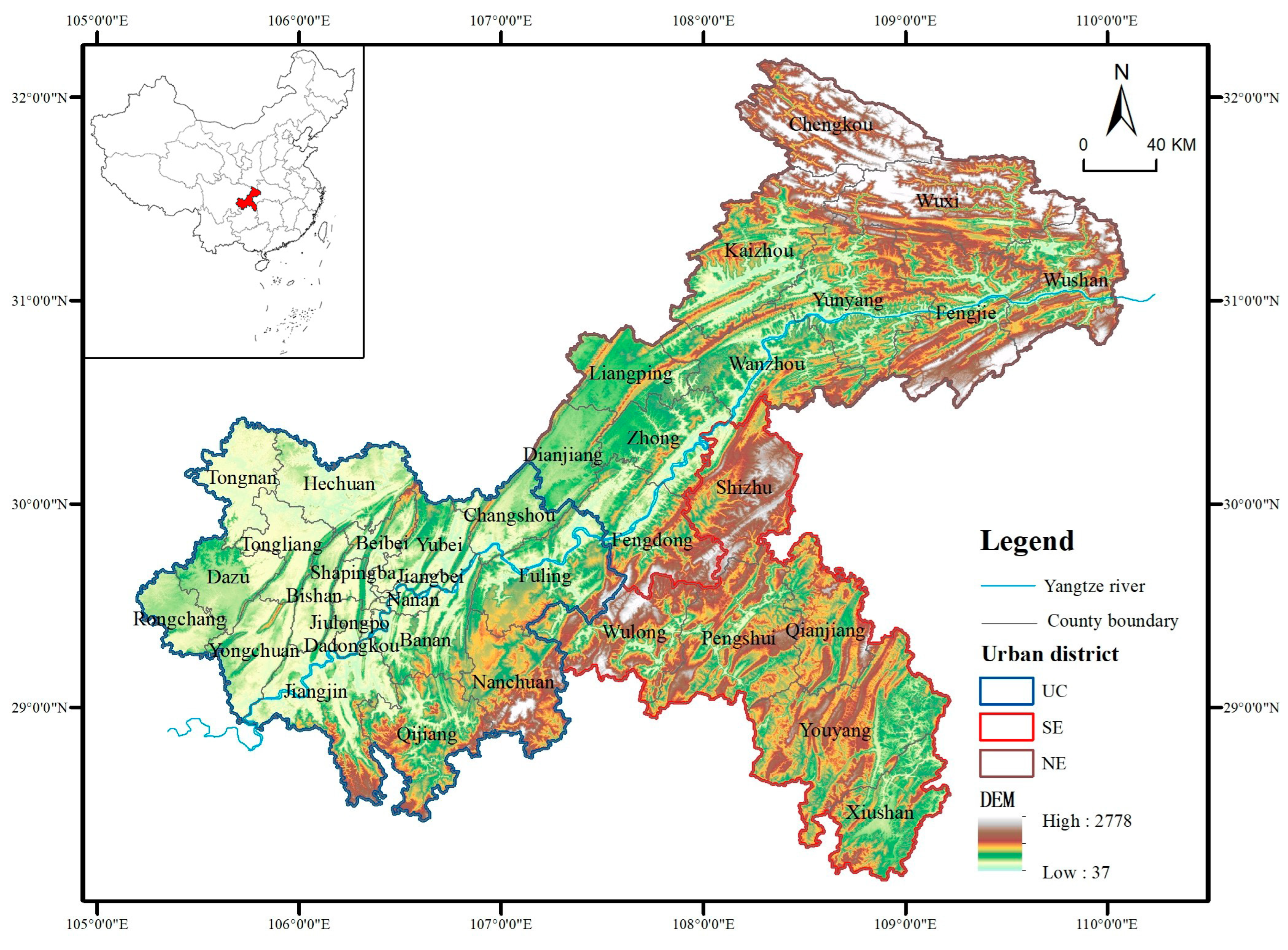
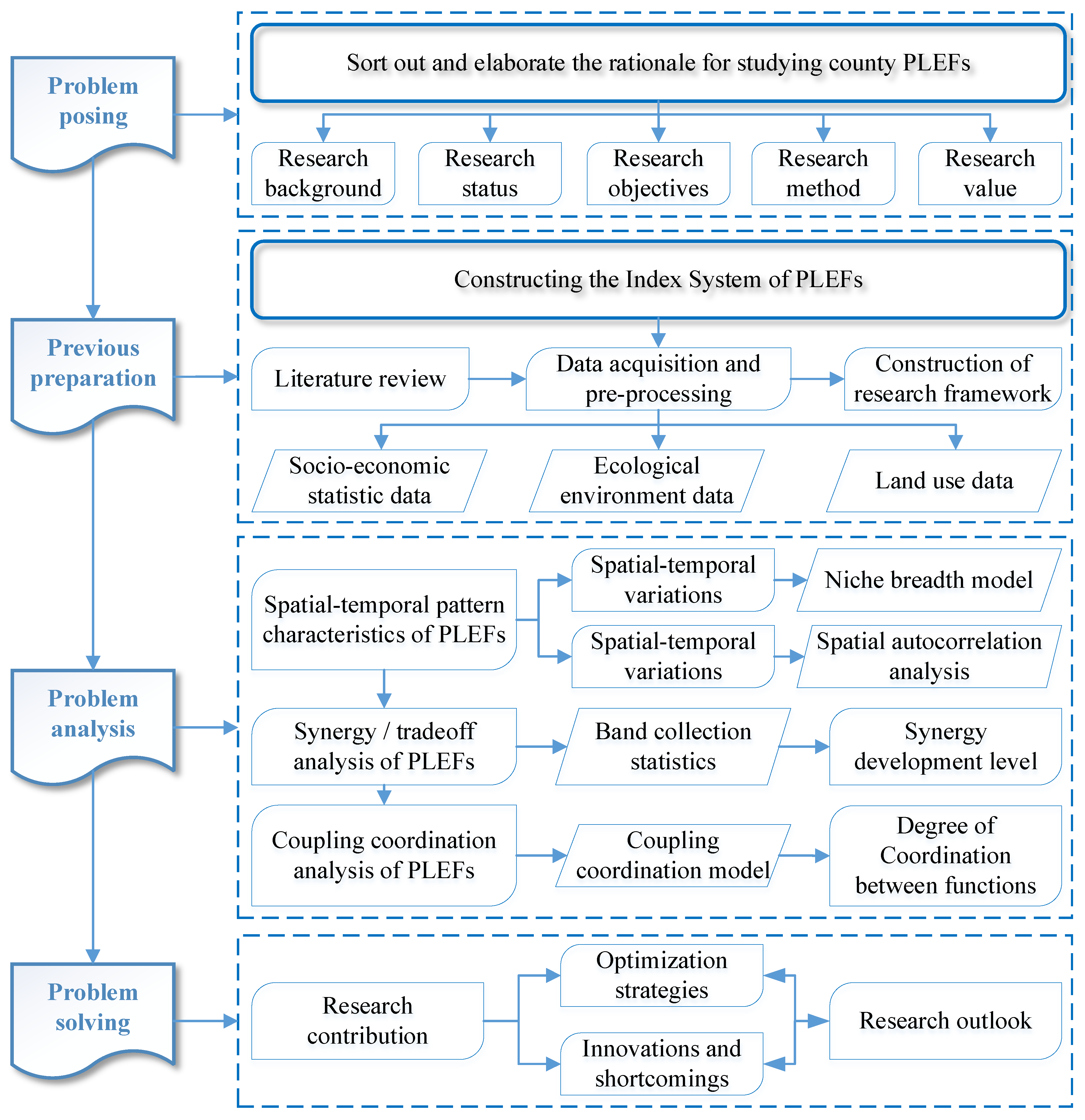
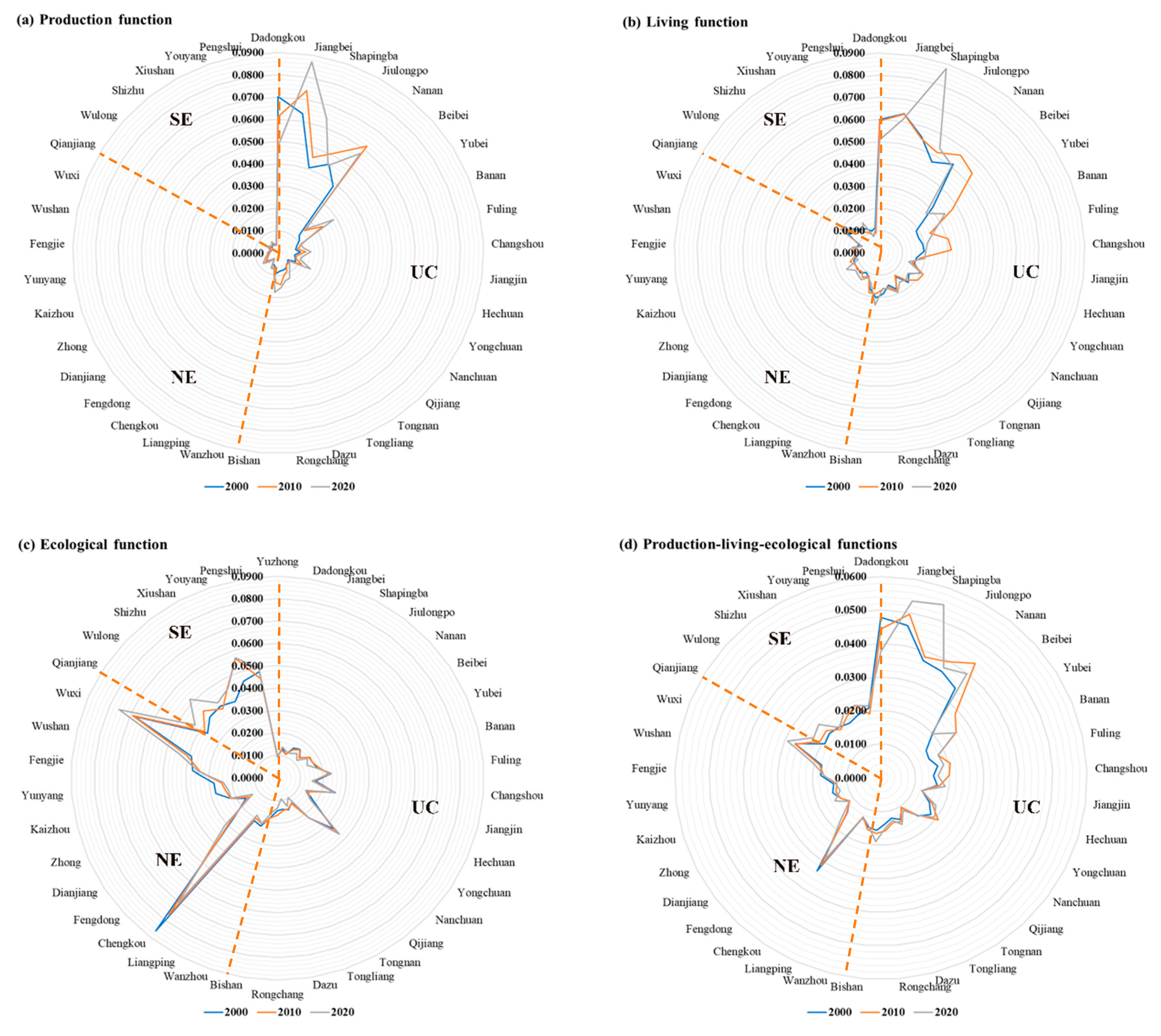

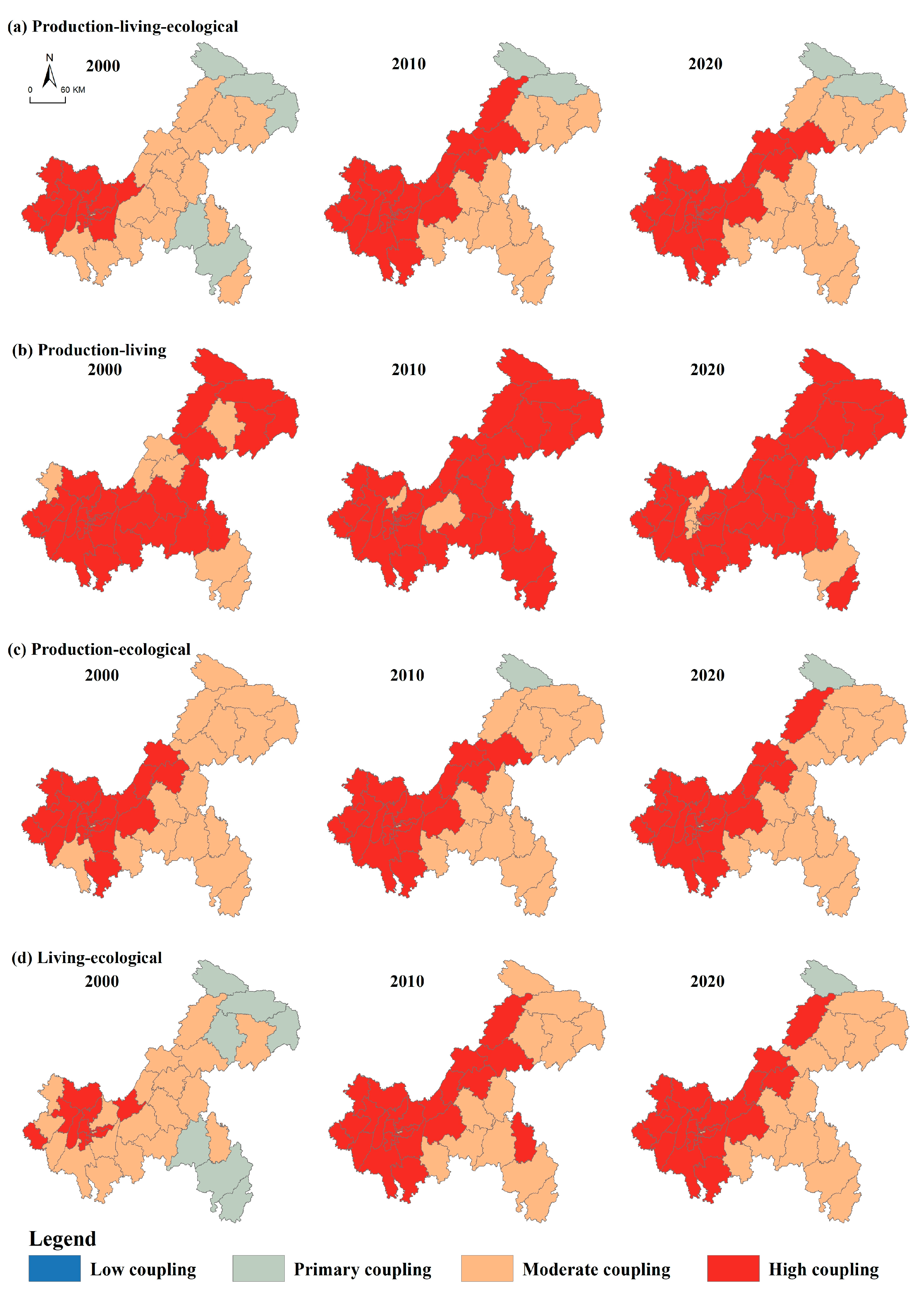
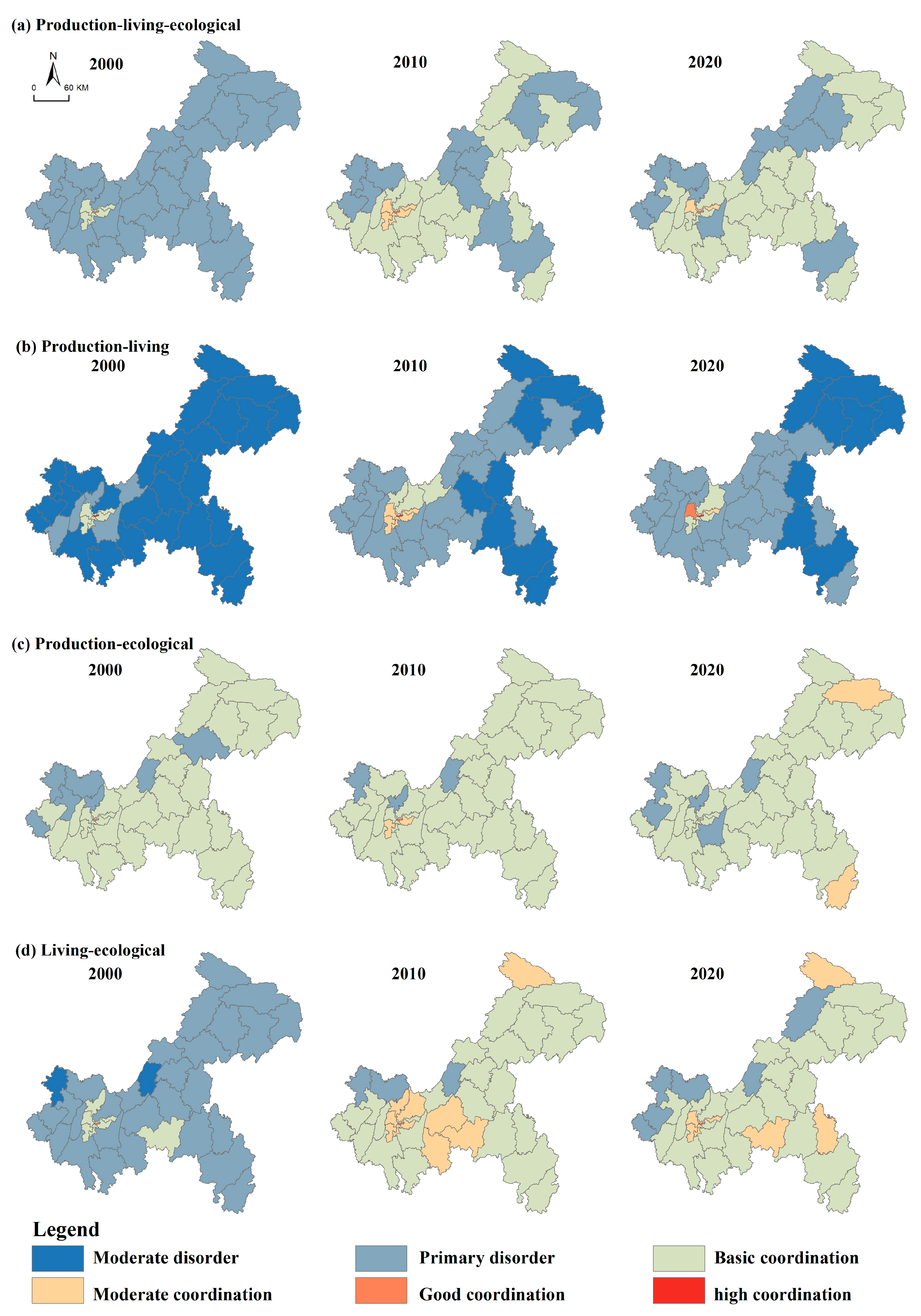
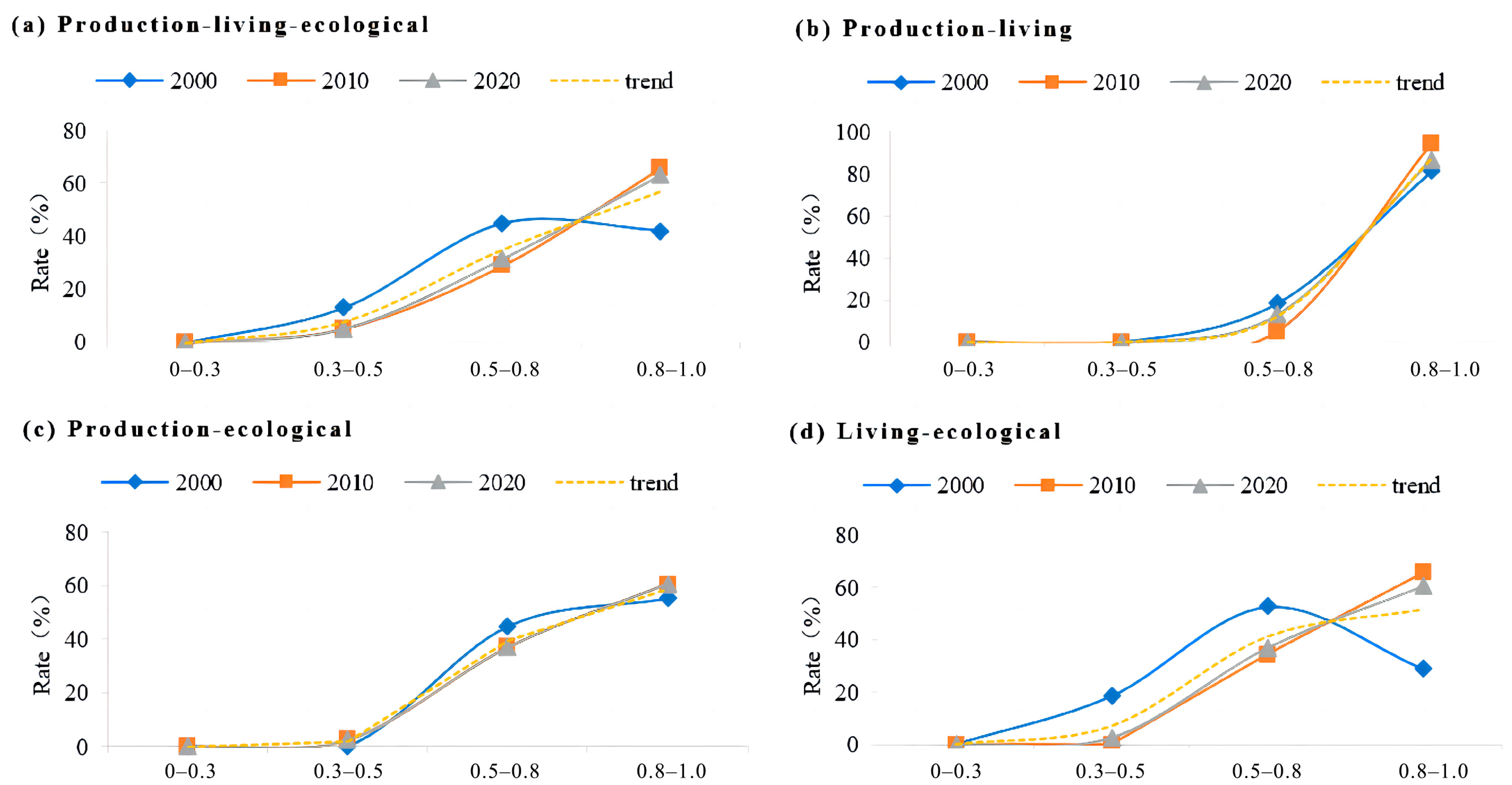
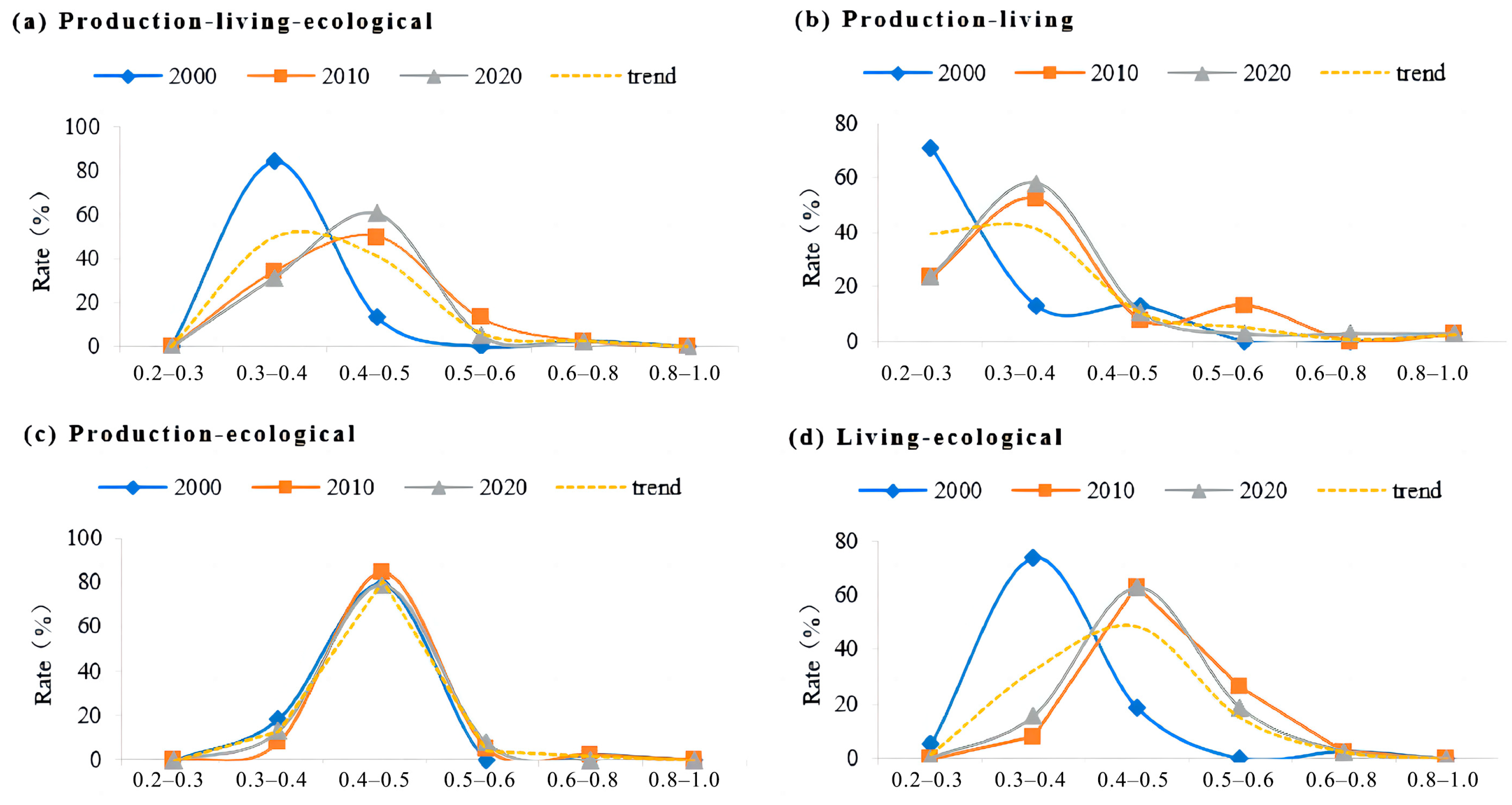
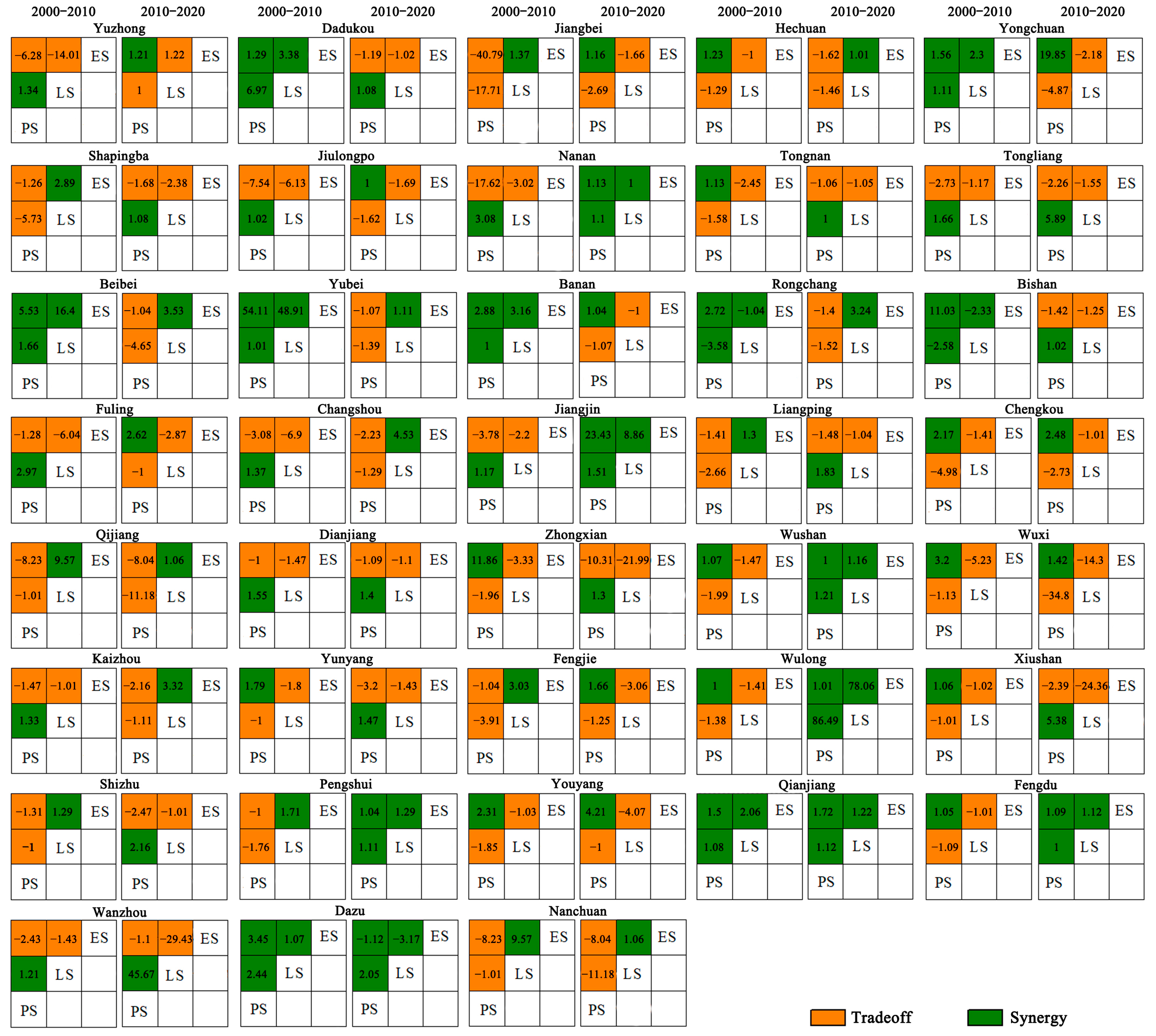
| Target Layer | Guidelines Layer | Metrics Layer | Indicator Interpretation and Calculation Method | Attribute | Entropy Method Weights | AHP Weight | Synthesis Weight |
|---|---|---|---|---|---|---|---|
| produce function | agriculture produce | Grain yield | Grain production/arable land area, t/km2 | + | 0.0186 | 0.0606 | 0.0396 |
| Land reclamation rate | Arable land area/total area of regional land, % | + | 0.0194 | 0.0606 | 0.0400 | ||
| Food availability per capita | Total food production/population, t/10,000 people | + | 0.0256 | 0.0909 | 0.0583 | ||
| economy develop | Average gross industrial production value | Gross Industrial Production/Total Land Area of the Region, 100 million yuan/km2 | + | 0.2026 | 0.2121 | 0.2074 | |
| Financial contribution rate | Local general budget revenue/total regional land area, billion yuan/km2 | + | 0.3641 | 0.2727 | 0.3184 | ||
| Economic density | Gross regional product/total land area of the region, 100 million yuan/km2 | + | 0.3697 | 0.3030 | 0.3364 | ||
| living function | living guarantee | Proportion of housing area | Total area of land used in settlements/area, %. | + | 0.3873 | 0.2652 | 0.3262 |
| Density of land used for transportation | Highway mileage/total area of land in the area, km/km2 | + | 0.0620 | 0.1189 | 0.0905 | ||
| population density | Total population/land area, people/km2 | 0.0066 | 0.0324 | 0.0195 | |||
| There are hospitals per 10,000 people Number of beds | Number of hospital beds/total population, sheets/10,000 | + | 0.1455 | 0.1621 | 0.1538 | ||
| society serve | Total retail sales of consumer goods per capita | Total retail sales of consumer goods/total population 100 million yuan/10,000 | + | 0.1763 | 0.1945 | 0.1854 | |
| Number of books in public libraries per capita | Number of books in public libraries/total population Book/person | + | 0.2224 | 0.2269 | 0.2246 | ||
| ecological function | ecological pressure | Agricultural fertilizer input intensity | Agricultural fertilizer application rate/cultivated land area, kg/km2 | 0.0525 | 0.1154 | 0.0840 | |
| Land degradation index | Degraded land area/total regional land area, % | 0.0514 | 0.1154 | 0.0834 | |||
| ecological conservation | Water per capita | Total water resources/total population, m3/person | + | 0.5852 | 0.3847 | 0.4850 | |
| Forest cover | Forest land area/total area of regional land, % | + | 0.1694 | 0.2308 | 0.2001 | ||
| Habitat abundance index | Status of biodiversity in the region | + | 0.1414 | 0.1538 | 0.1476 |
| Coupling Phase | Coupling Type | Degree of Coupling |
|---|---|---|
| Coordinated coupling period | Highly coupled | 0.8–1.0 |
| Run-in period | II Moderately coupled | 0.5–0.8 |
| Antagonistic period | III Primary coupling | 0.3–0.5 |
| Low coupling period | IV low-level coupling | 0.0–0.3 |
| Coordination Phase | Coupling Coordination Type | Degree of Coordination |
|---|---|---|
| Coordinated period | Highly coordinated | 0.8–1.0 |
| II Well coordinated | 0.6–0.8 | |
| III moderate coordination | 0.5–0.6 | |
| IV Essential coordination | 0.4–0.5 | |
| Periods of misalignment | V Primary dysregulation | 0.3–0.4 |
| VI moderate outrage | 0.2–0.3 | |
| VII Severe dysregulation | 0.0–0.2 |
| Year | Global Moran’s I | Z-Score | ||||
|---|---|---|---|---|---|---|
| Production Features | Living Function | Ecological Function | Production Features | Living Function | Ecological Function | |
| 2000 | 0.1056 | 0.2845 | 0.5872 | 4.1926 | 5.2513 | 5.9643 |
| 2010 | 0.1717 | 0.4645 | 0.6007 | 5.0186 | 5.8778 | 5.8525 |
| 2020 | 0.2119 | 0.4768 | 0.6405 | 5.1811 | 6.0668 | 6.0518 |
Disclaimer/Publisher’s Note: The statements, opinions and data contained in all publications are solely those of the individual author(s) and contributor(s) and not of MDPI and/or the editor(s). MDPI and/or the editor(s) disclaim responsibility for any injury to people or property resulting from any ideas, methods, instructions or products referred to in the content. |
© 2023 by the authors. Licensee MDPI, Basel, Switzerland. This article is an open access article distributed under the terms and conditions of the Creative Commons Attribution (CC BY) license (https://creativecommons.org/licenses/by/4.0/).
Share and Cite
Cheng, L.; Cui, H.; Liang, T.; Huang, D.; Su, Y.; Zhang, Z.; Wen, C. Study on the Trade-Off Synergy Relationship of “Production-Living-Ecological” Functions in Chinese Counties: A Case Study of Chongqing Municipality. Land 2023, 12, 1010. https://doi.org/10.3390/land12051010
Cheng L, Cui H, Liang T, Huang D, Su Y, Zhang Z, Wen C. Study on the Trade-Off Synergy Relationship of “Production-Living-Ecological” Functions in Chinese Counties: A Case Study of Chongqing Municipality. Land. 2023; 12(5):1010. https://doi.org/10.3390/land12051010
Chicago/Turabian StyleCheng, Ling, Haiyang Cui, Tian Liang, Dan Huang, Yuanxia Su, Zhiyong Zhang, and Chuanhao Wen. 2023. "Study on the Trade-Off Synergy Relationship of “Production-Living-Ecological” Functions in Chinese Counties: A Case Study of Chongqing Municipality" Land 12, no. 5: 1010. https://doi.org/10.3390/land12051010
APA StyleCheng, L., Cui, H., Liang, T., Huang, D., Su, Y., Zhang, Z., & Wen, C. (2023). Study on the Trade-Off Synergy Relationship of “Production-Living-Ecological” Functions in Chinese Counties: A Case Study of Chongqing Municipality. Land, 12(5), 1010. https://doi.org/10.3390/land12051010









